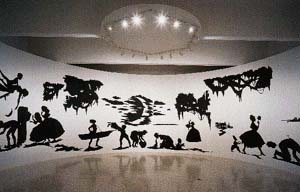Shanzia Sikander
She was born in 1969 in Lahore, Pakistan. Educated as an undergraduate at the National College of Arts in Lahore, she received her MFA in 1995 from the Rhode Island School of Design. Sikander specializes in Indian and Persian miniature painting, a traditional style that is disciplined. While becoming an expert in this technique-driven, often impersonal art form, she imbued it with a personal context and history, blending the Eastern focus on precision and methodology with a Western emphasis on creative, subjective expression. Sometimes working several years for one single piece, arranging everything to be near and precise, self expression comes later, she says. As opposed to her miniatures, her installation pieces are huge and consumes much less time. Reared as a Muslim, Sikander is also interested in exploring both sides of the Hindu and Muslim “border,” often combining imagery from both—such as the Muslim veil and the Hindu multi-armed goddess—in a single painting. Sikander has received many awards and honors for her work, including the honorary artist award from the Pakistan Ministry of Culture and National Council of the Arts. Sikander resides in New York and Texas.
Walton Ford

He was born in 1960 in Larchmont, New York. Ford graduated from the Rhode Island School of Design with the intention of becoming a filmmaker, but later adapted his talents as a storyteller to his unique style of large-scale watercolor. Blending depictions of natural history with political commentary, Ford’s meticulous paintings satirize the history of colonialism and the continuing impact of slavery and other forms of political oppression on today’s social and environmental landscape. Each painting is as much a tutorial in flora and fauna as it is as a scathing indictment of the wrongs committed by nineteenth-century industrialists or, locating the work in the present, contemporary American consumer society. An enthusiast of the watercolors of John James Audubon, the most famous naturalist painter from the 19th century, Ford celebrates themyth surrounding the renowned naturalist-painter while simultaneously repositioning him as an infamous anti-hero who, in reality, killed more animals than he ever painted. He is playing that role in a conscious way: he reinevents the ruined tradition.
Each of Ford’s animal portraits doubles as a complex, symbolic system, which the artist layers with clues, jokes, and erudite lessons in colonial literature and folktales. Walton Ford is the recipient of several national awards and honors including a fellowship from the John Simon Guggenheim Memorial Foundation and the National Endowment for the Arts. Ford’s work has been featured at Bowdoin College Museum of Art, the Southeastern Center for Contemporary Art, the Whitney Museum of American Art at Champion, and the Forum for Contemporary Art in St. Louis. After living in New York City for more than a decade, Walton Ford relocated his studio to Great Barrington, Massachusetts. Ford and his family reside in upstate New York.
For his works of art, please click here!
Kara Walker

She was born in Stockton, California in 1969. She received a BFA from the Atlanta College of Art in 1991 and an MFA from the Rhode Island School of Design in 1994. The artist is best known for exploring the raw intersection of race, gender, and sexuality through her iconic, silhouetted figures. Walker unleashes the traditionally proper Victorian medium of the silhouette directly onto the walls of the gallery, creating a theatrical space in which her unruly cut-paper characters fornicate and inflict violence on one another. Her technique is extremely cinematic but rooted in drawing. In recent works like "Darkytown Rebellion" (2000), the artist uses overhead projectors to throw colored light onto the ceiling, walls, and floor of the exhibition space. When the viewer walks into the installation, his or her body casts a shadow onto the walls where it mingles with Walker’s black-paper figures and landscapes: she projects fiction into those facts. With one foot in the historical realism of slavery and the other in the fantastical space of the romance novel, Walker’s nightmarish fictions simultaneously seduce and implicate the audience. Thus fact and fiction, black and white go together in her work. Walker’s work has been exhibited at the Museum of Modern Art, the San Francisco Museum of Modern Art, the Solomon R. Guggenheim Museum, and the Whitney Museum of American Art. A 1997 recipient of the John D. and Catherine T. MacArthur Foundation Achievement Award, Walker was the United States representative to the 2002 São Paolo Bienal in Brazil. Walker currently lives in New York where she is on the faculty of the MFA program at Columbia University.
for the article on Kara Walker, Cut it Out, by Hilarie M. Sheets please click here!
No comments:
Post a Comment